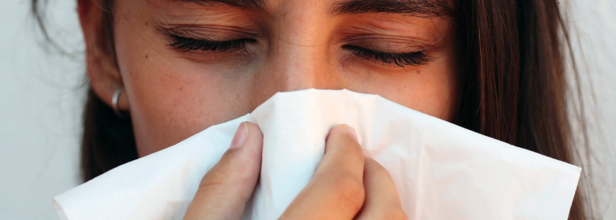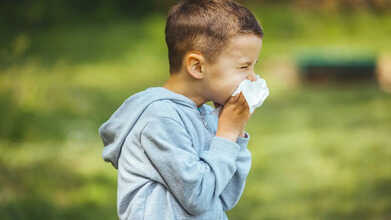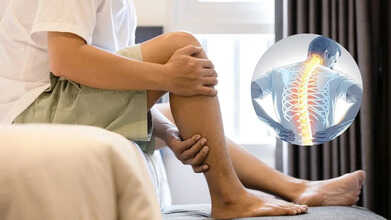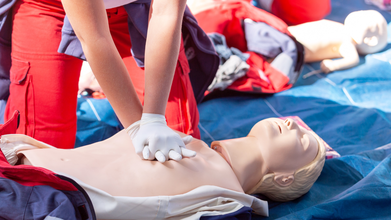- Health Conditions A-Z
- Health & Wellness
- Nutrition
- Fitness
- Health News
- Ayurveda
- Videos
- Medicine A-Z
- Parenting
- Web Stories
Should You Spit Your Mucus Out? Here's What Experts Say

Credits: Canva
The United State is facing many diseases all at once, while the cases of bird-flu are rising, respiratory viruses are also spreading across the country. The Centers for Disease Control and Prevention (CDC) predicts that COVID-19, the flu, and RSV cases will jump over the next few weeks. While the symptoms for these three may vary, what is common in all is the extra mucus in your throat and chest.
Have you fallen sick and thought about what to do with the excess mucus production? At times, when you are in public, have you ever thought of what to do with the extra mucus? Should you spit it out, or swallow it? If at all this impacts your recovery? We've the answers.
What Is Mucus?
It is a substance that lines the moist surface of our body, including lungs, sinuses, mouth, stomach, intestine and even eyes. What is it made of? It mostly contains water and large molecules called glycoproteins, which are a hybrid of sugars and protein that gives mucus its thick and sticky consistency. It also has other components like salts, and molecules from our immune defense system. So does that mean spitting out your mucus may take away immune defense system's molecules out of your body?
While it is a lubricant which also provides a barrier between you and the outside world as it filters whatever you breathe in, it also traps debris, allergens, viruses, and bacteria from going into your airways.
So, why do we get mucus when we are sick?
Extra mucus is one of the common signs that you are sick and that you immune system is working hard. Mucus contains antibodies that help fight foreign substances, and lysozyme, an enzyme that combats bacteria.
So, when we get sick, our body produces more mucus as a manner of defending itself. Furthermore, the extra mucus also helps wash the pathogens away.
ALSO READ: Natural Remedies For 6 Common Ailments To Boost Immunity And Destress
What should we do with the extra mucus?
Excess mucus, whether in your throat or your lungs should be spit out. Most doctors too agree with this. While mucus does protect you, the one that is produced when you are sick is filled with irritants, allergens, and infectious organisms that must be cleared from the body. Doctors also recommend spitting it out to open up the drainage pathways of your nose and sinuses.
While there are some notions that suggests that swallowing cough could harm your stomach or intestines, doctors say that there are no such evidence for this. Experts suggest that even if you swallow your mucus, it gets eliminated through the gastrointestinal tract. This means our GI tract breaks the mucus down, and we eventually excrete it.
While spitting out mucus can make us feel better in the moment, on an average, we sallow mucus all day, all of this gets broken down in our GI tract.
How can one get rid of the extra mucus
To clear the mucus when you are sick, here are somethings you can do:
- Stay hydrated, as dehydration can make the mucus even more thick and could be difficult to clear
- Use nasal irrigation. It is a tool like a neti pot that can help wash out mucus that has bacteria and viruses trapped in it
- Saline spray helps loosen mucus and move it out of your sinuses
- A steamy shower can also help with the same
- If none of that works, you can always use over-the-counter medications to reduce the amount of mucus
Think You Have Flu or Covid? Your ‘Winter Cold’ Could Be Hiding THIS Serious Condition

Credits: Canva
Sniffles and other symptoms often mistaken for a winter virus such as Covid or flu could actually be caused by something else, according to a pharmacist. George Sandhu, deputy superintendent at Well Pharmacy, explained that pollen allergies are now extending into autumn as seasons stretch longer.
He said: “Warmer temperatures are lengthening growing seasons, so pollen counts are higher than in past decades. Rising carbon dioxide levels don’t just warm the planet, they also act like a fertiliser for plants, increasing pollen production.”
What Is a Pollen Allergy?
A pollen allergy happens when your immune system reacts to pollen, which is a fine powder released by trees, grasses, and weeds during reproduction. In people with this allergy, the immune system mistakes pollen for a harmful substance and releases chemicals such as histamine.
This can trigger symptoms like sneezing, runny or blocked nose, itchy or watery eyes, and throat irritation. This condition is commonly called hay fever and tends to appear during certain times of the year when specific plants are blooming, according to the Cleveland Clinic.
Sandhu added that milder winters are allowing some plants to start producing pollen earlier in spring and continue later into autumn. He noted: “Late summer also sees a shift from weed pollen to increased indoor mould, leaf mould, and dust mites, which all peak during autumn. Combined with damp autumn conditions, people with allergies now face a much longer ‘high-risk window’ every year.”
Types of Pollen Allergens
The pharmacist explained the three main types of allergens:
- Weed pollen: including ragweed, mugwort, plantain, nettle, dock, goosefoot, and sorrel.
- Mould spores: thrive in damp autumn conditions and can be found in rotting leaves, compost heaps, soil, as well as bathrooms, kitchens, and other damp areas.
- House dust mites: found in bedding, carpets, soft toys, and fabrics.
Best Treatment for a Pollen Allergy
The best way to manage pollen allergies depends on how severe they are and what suits your body. What helps one person may not work for another. A healthcare provider can recommend the most effective treatment. According to Sandhu, “Antihistamines can relieve sneezing, runny nose, and itching, for example, cetirizine or loratadine. Nasal corticosteroid sprays, such as fluticasone or mometasone, reduce inflammation and congestion. Decongestants may give short-term relief for a blocked nose, but they shouldn’t be used long-term. Saline sprays or rinses can help clear allergens from the nose, and eye drops can soothe itchy, watery eyes.”
Can Allergy Shots Work Against Pollen Allergy?
Allergy shots gradually retrain your immune system to tolerate pollen. They involve a series of injections containing pollen, with the dose slowly increased over time. This helps your body build tolerance. Allergy shots are administered by a healthcare provider.
While it is impossible to avoid pollen completely, you can change some daily habits to reduce exposure. For instance, try not to be outside on warm, windy spring days when pollen levels are high. Pollen counts are usually highest in the early morning and early afternoon.
8 Everyday Habits That Could Be Making Your Bones Weak, Experts Warn

Credits: Canva
You might assume weak bones are a concern only for older adults, but bone strength starts to decline much earlier than most people realise. Often, the first sign that something is wrong comes after a simple fall results in a fracture. Every year, around 50,000 such incidents occur in the UK, and for many, the real shock comes later, when they are told they have osteoporosis, the bone-thinning condition that weakens the skeleton.
An estimated 3.5 million people live with it, while another million have osteopenia, a mild form of bone loss that increases the likelihood of painful and sometimes life-changing fractures.
What Is Osteoporosis?
Osteoporosis is a condition that causes bones to become weak and brittle. It reduces bone density, making them thinner and more fragile. People with this condition are much more prone to fractures, even from minor falls or bumps.
Healthy bones are normally dense and strong enough to bear weight and cushion impact. But as we age, they naturally lose some of their strength and ability to rebuild themselves. When osteoporosis sets in, this process speeds up, leaving bones weaker and far more likely to break. Most people are unaware they have it until a fracture reveals the damage already done.
Daily Habits That Might Be Weakening Your Bones
Hormone specialist Dr Nicky Keay, Honorary Clinical Lecturer at University College London and author of “Myths of Menopause,” explains, “Your skeleton gives your body structure and stability, protects vital organs, and works with muscles to enable movement.” Bones also store essential minerals such as calcium, phosphorus, and magnesium, and the marrow inside certain long bones produces red and white blood cells.
Below are some everyday habits that could be slowly draining your bone strength, and how to counter them.
Dieting: Repeated cycles of losing and regaining weight can harm your bone density,” says dietitian Lorna Cooke from the Sports Institute of Northern Ireland. “Restrictive eating can disturb hormone balance and deprive your body of calcium and other nutrients vital for bone health. When dietary calcium is lacking, the body draws it from bones, which weakens them over time.”
What to do: “Losing weight gradually is safer for bones,” says Lorna. She further suggests sticking to regular, balanced meals so that your body stays nourished. This approach helps you keep the weight off in the long run without harming bone health.
Lack of Vitamin D: “One of the main causes of osteoporosis is vitamin D deficiency,” says Dr Eamon Laird, vitamin D researcher at Trinity College Dublin. “This ‘sunshine vitamin’ is produced when sunlight hits the skin, but during winter, we can’t make enough of it in northern climates.” Because diet alone doesn’t supply sufficient vitamin D, supplementation is often necessary.
What to do: Nutritionist Rob Hobson from Healthspan advises, “Adults should take at least 10 µg of vitamin D daily during winter, and year-round if they’re over 65, spend little time outdoors, or have other risk factors.”
Menopause Matters: Falling oestrogen levels after menopause accelerate bone loss, particularly the hormone oestradiol, which normally helps slow the breakdown of bone tissue. Women can lose around 0.5% of bone density each year after menopause, and by their mid-40s, many already have significant bone reduction.
What to do: Consultant Gynaecologist Tania Adib from The Medical Chambers Kensington recommends, “Women around 45 should have a DXA scan to assess bone density. Building bone strength early and maintaining it through menopause is crucial. Focus on weight-bearing exercise, proper sleep, and a balanced diet.” In some cases, HRT can help prevent bone loss, especially in women experiencing early menopause or severe symptoms.
Ultra-Processed Foods: Strong bones depend on diets rich in calcium and vitamin D, said Rob Hobson. “A diet full of ultra-processed foods lacks the essential nutrients needed for bone strength. These foods often provide excess calories but very few vitamins and minerals.”
What to do: Cut back on ultra-processed foods and cook more from fresh ingredients. A balanced diet that includes wholegrains, lean proteins, fruits, vegetables, and healthy fats ensures your bones get the nourishment they need at every stage of life.
Long-Term Medicines or Illness: Certain conditions, like an overactive thyroid, can increase the rate at which bones lose density. A guide by Viridian Nutrition and GP Dr Siobhan Brennan, notes that some weight-loss drugs, steroids, cancer treatments, antidepressants, and proton-pump inhibitors can also affect bone strength.
What to do: Speak with your doctor or pharmacist about reviewing your medication.
Ditching Dairy Products: Dairy products like milk, yogurt, and cheese are excellent sources of calcium, said Lorna. She further told us, “Cutting them out, whether due to veganism or dietary restrictions, can reduce calcium and vitamin D levels, raising the risk of osteoporosis.”
What to do: Adults need about 1,000 mg of calcium daily. “If you don’t consume dairy, replace it with fortified foods such as plant-based milks or breads, calcium-rich greens, tofu, nuts, seeds, dried fruit, and pulses,” says Lorna.
Gut Diseases: Conditions like Crohn’s disease or colitis can damage the intestine, impairing the absorption of key nutrients such as calcium and vitamin D,” Lorna explains. If untreated, this can eventually lead to osteoporosis.
What to do: Early diagnosis and, if necessary, a specialist diet guided by a dietitian can help the gut heal and absorb nutrients again. Calcium and vitamin D supplements may be prescribed, and a bone scan at diagnosis is a good preventive step.
Too Much or Too Little Exercise: Exercise plays a crucial role in maintaining bone health, but both inactivity and overtraining can cause harm. “Most people do too little, which increases their risk of brittle bones—even in their 30s or 40s,” says Dr Laird.
What to do: Aim for at least 30 minutes of physical activity daily, advises Dr Laird. Include weight-bearing exercises, like walking or jogging, which help keep bones strong and resilient.
How Can You Help A Person Or Child Choking? New American Heart Association Guidelines Explains What To Do

(Credit-Canva)
The American Heart Association (AHA) has released its new "2025 CPR and Emergency Care Guidelines." This is the first full update to these life-saving rules since 2020. The new advice includes better ways to handle choking and suspected opioid overdose, along with other steps to save a life.
Every year, about 350,000 people in the U.S. experience sudden cardiac arrest outside of a hospital, and nearly 90% of them do not survive. The AHA’s new guidelines, its first full update since 2020, offer science-backed instructions that make emergency response easier for everyone to understand and apply.
What To Do When A Person Is Choking
The instructions for helping someone who is choking are now clearer and apply to all ages:
For Adults and Older Children (who are awake)
You should switch back and forth between giving five back blows (hits on the back) and five abdominal thrusts (the Heimlich maneuver). Keep doing this until the object comes out or the person passes out.
This is new for adults, and the old rules for children just said to do abdominal thrusts.
For Infants
You should switch back and forth between giving five back blows and five chest thrusts, which are pushes on the chest, using the heel of one hand. Keep going until the object comes out or the baby passes out.
Do not use abdominal thrusts on infants, as it could seriously hurt them.
How To Spot an Opioid Overdose
The guidelines have new advice for helping someone who might have overdosed on opioids. Opioids cause many drug overdose deaths because they slow down the part of the brain that controls breathing. Watch for these signs of a suspected opioid overdose:
- Breathing is slow, very shallow, or has stopped.
- Making choking or gurgling noises.
- Feeling very sleepy or passing out.
- The pupils (black centers of the eyes) are very small and tight.
- The skin, lips, or fingernails look blue or gray.
What You Need To Know About CPR
The AHA also worked with pediatric experts to update the rules for kids and newborns:
Helping Newborns
For most newborns who don't need immediate help, the updated rule now recommends a slight delay, asking doctors to wait at least 60 seconds before cutting the umbilical cord. This simple change is crucial for the baby's health, as it allows more blood to flow to the infant, improving their blood and iron levels.
Easier CPR Steps
The complicated, separate steps previously used to guide rescuers have been replaced with a single, simple "Chain of Survival." This new chain clearly stresses that when a person's heart stops, it is absolutely essential to quickly perform both chest compressions and rescue breaths, especially for infants and children, to give them the best chance of surviving.
Training Younger People
New research shows that kids who are 12 years old or older can be successfully trained to perform high-quality CPR and even learn to use a defibrillator. The American Heart Association wants everyone to take a class to learn these vital skills, encouraging more training programs and public education efforts so that communities are better prepared for medical emergencies.
The AHA urges everyone to take a CPR class to learn these life-saving skills. They are encouraging more training and public campaigns to make sure everyone is ready to help in an emergency
© 2024 Bennett, Coleman & Company Limited

